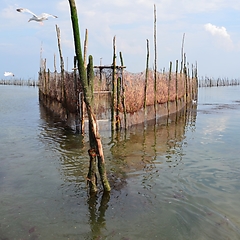“River fishing" is practised on a small scale in the Rhine and Maas system and is formally part of "inland fishing". When fishing, one uses a vessel and dinghy equipped with a "bun" or "beun". This is a compartment in the vessel that is directly connected to the river water via many small holes, allowing the fish to be kept alive. The fishermen stay on the ship day and night during the working week and fishing is only done in areas where the fishermen have 'fishing rights' by agreement or where they have old commercial fishing rights. By fishing the waters to full cargo capacity and then moving on, the natural balance of the fish stock is maintained and the fishing waters sustainably utilised. In addition to fishing for consumption fish and fry, the fishermen also carry out research and stock recovery projects.
In the period from November to April, 'standing rigging' is used to fish for table fish, particularly pikeperch, perch, pike, bream and roach. The net is placed perpendicular to the seabed so that the (scale) fish swim against it and get stuck in the mesh of the net with their gills. The fish is sold via the IJmuiden fish auction, IJsselmeer auction Urk and to local buyers.
Because the low temperature means that the fish caught is significantly less damaged, fishing for fry also takes place during this period, with the catches being released elsewhere for fish stock recovery projects. In addition, the fishermen also carry out 'yielding' orders during this period. This means catching all the fish in a water, which is required if a water authority such as the Department of Public Works is renovating or constructing water or artworks.
Fyke fishing takes place from April to November. The assignment or the intended result determines the use of the various species, materials, mesh sizes and sizes of the fykes. The fish and salmon fykes are used for the registration and measurement of fish species on behalf of Imares Wageningen UR. In addition, the 'Eel over the Dike' project catches eels that have reached sexual maturity in front of hydropower plants and pumping stations and releases them downstream behind these barriers so that they can migrate to the Sargasso Sea to spawn.
Research and recovery activities take place throughout the year.



